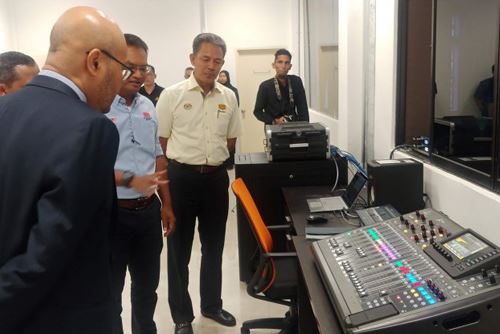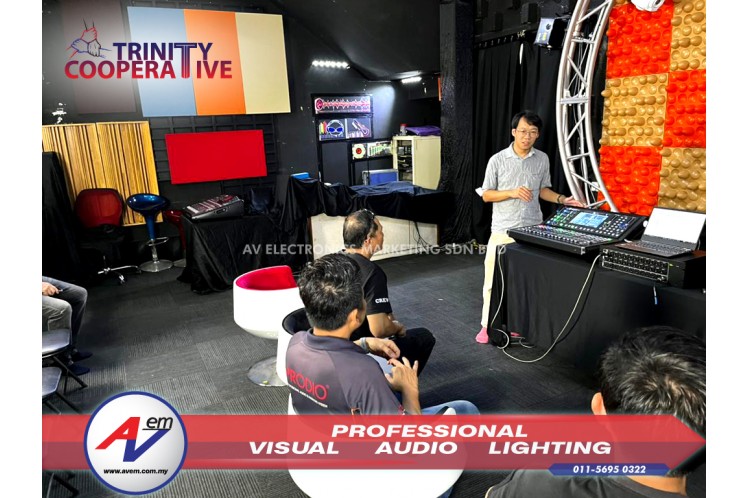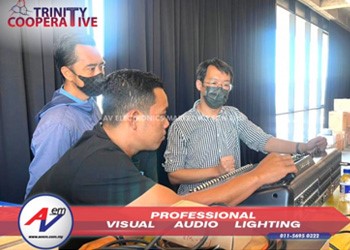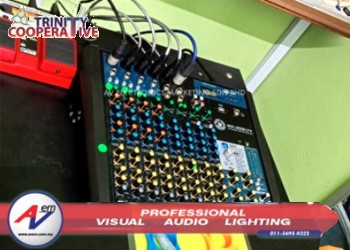AVEM Classroom 10 - Sound Capture & Microphones
How do these basics apply to the AV industry? They help you understand the electrical pathway used to amplify sound.
In its most basic form, the complete audio-signal path takes acoustic energy and converts it into electrical energy so it can be routed, processed, further amplified, and converted back into acoustic energy, as follows:
- The sound source creates sound wave vibrations in the air.
- A microphone picks up the vibrations.
- The microphone converts the vibrations into an electrical signal.
- The electrical signal is processed.
- The signal ends up in an output device (such as an earphone or a loudspeaker).
- The output device converts the electrical signal back into sound waves.
This conversion of energy from one form to another is called transduction. A microphone is a transducer—it converts acoustic energy into electrical energy. A loudspeaker is also a transducer—it converts electrical energy into acoustic energy. This means you can have transducers in either end of an electrical audio path.

Microphones
Understanding a microphone's construction and its intended usage, as well as its directional, sensitivity, frequency response, and impedance characteristics, will help you select the appropriate microphone for each situation.
Microphones comes in a variety of types, sizes, and construction Carbon microphones were once widely used in telephones. There are also ceramic, fiber-optic, laser, piezoelectric, ribbon, moving coil, microelectromechanical systems (MEMS), condenser, and electret microphones, each with its own application and characteristics.
Dynamic Microphones

In a dynamic microphone (mic). you will find a coil of wire (a conductor) attached to a diaphragm and placed in a permanent magnetic field. Sound pressure waves cause the diaphragm to move back and forth, thus moving the coil of wire attached to it.
As the diaphragm-and-coil assembly moves, it cuts across the magnetic lines of flux of the magnetic field, inducing a voltage into the coil of wire. the voltage induced into the coil is proportional to the sound pressure and produces an electrical audio signal. The strength of this signal is very small and is called a mic-level signal.
Dynamic microphones are used in many situations because they are economical and durable,and they will handle high sound presure levels. Dynamic microphones are very versatile because they do not require a power source.
Condenser Microphones
.jpeg)
In the study of electricity, you will find that if you have two oppositely charged (polarized) conductors separated by an insulator, an electrical field exists between the two conductors. The amount of potential charge (voltage) that is stored between the conductors will change depending on the distance between the conductors, the surface area of the conductors, and the dielectric strength of the insulating material between the two conductors. An elecronic component that uses this principle is called a capacitor.
A condenser microphone contains a conductive diaphragm and a conductive backplate. Aire is used as the insulator to separate the diaphragm and backplate. Electical power is required to polarize, or apply, the possitive and negative charges to create the electrical field between the diaphragm and backplate.
Sound pressure waves cause the diaphragm to move back and forth, subsequently changing the distance (spacing) between the diaphragm and backplate. As the change, the amount of charge, or capacitance, stored between the diphragm and backplate changes. This change in capacitance produces an electrical signal.

The strength of the signal from a condenser microphone is not as strong as the mic level signal from a typical dynamic microphones. To increase the signal, a condenser microphone includes a preamplifier, powered by the same power supply used to charge the plates in the microphone. This preamplifier amplifies the signal in the condenser microphone to a mic-level signal but is not to be confused with a microphone amplifier found in a mixing console.
The power supply to charge the capacitor elements and drive the preamplifier may be a battery included in the microphone body, an external mains-powered supply device, or come from an external phantom power supply system.
As the diaphragm used in a condenser microphone is usually lower in mass than other microphone types, the condenser microphone tends to be more sensitive than other types and respond better to higher frequencies, with a wider overall frequency response.
Electret Microphones
An electret microphone is a type of condenser microphone. The electret microphone gets its name from the prepolarized material, or the electret, applied to the microphone's diaphragm or backplate.
The electret provides a permanent, fixed charge for one side of the capacitor configuration. This permanent charge eliminates the need for the higher voltage required for powering the typical condenser microphone. This allows the electret microphone to be powered using small batteries, or normal phantom power. Electret microphones are physically small, lending themselves to a variety of uses and quality levels.
MEMS Microphones
A microelectromechanical system (MEMS) microphone is a member of a group of mechanical devices that are built directly onto silicon chips using the same deposition and ethcing processes used to construct microprocessors and memory systems. They are minute mechanical devices that can be directly integrated with the pure electronic circuitry of the chip. The best known of these in the AV world are the digital micromirror devices (DMD) used for light switching in DLP projectors. Many other MEMS devices are in wide commerical use as accelerometers, air pressure sensors, gyroscopes, optical switches, ink-jet pumps, and even microphones.
Microphones buit using MEMS technologies are generally variations on either condenser microphone or piezo-electric (electrical signals produced by the mechanical movement of a crystal) microphones. Although their tiny size means that MEMS microphones are not particularly sensitive, especially at bass frequencies, the huge advantage of MEMS microphones is that they can be placed on the same as the amplifiers and signal processors that manage both gain and frequency compensation. The on-chip processing can include analog-to-digital conversion, resulting in a microphone with a direct digital output. In addtion to dedicated MEMS microphones, smartphones, smart speakers, tablet computers, virtual reality headsets, and wearable devics can incoporate chips that include a range of MEMS devices, including microphones, accelerometers, and gyroscopes, and all of their associated processing circuitry.
- active loudspeaker
- active speaker
- active subwoofer
- alto
- analog crossover
- analog equalizer
- analog mixer
- audiocenter
- b205d
- behringer
- bmb
- bosch
- box speaker
- church
- column speaker system
- convention center
- csp-610
- csp612
- css1720
- csw-115
- da2250
- da2500
- dad-500
- dad950
- dar-350h
- dcx2496le
- digital loudspeaker management
- digital mixer
- digital snak2
- digital snake
- dl16
- dlm408plus
- dm220
- dm24.8
- dm-24.8
- dm48.20
- dpe-2.10
- dpm4.13mk2
- dsp5211
- dsppa
- dsspa
- dvs-4t
- ea5118
- education
- emix
- emma-120b
- emma-835zsmkll
- empa-8250mkii
- empa-8500
- empa-8500 mkii
- empa-8500mkll
- emws884
- emws884b
- emws-884w
- ep1500
- ep2000
- ep512
- fbq-1502
- fbq-1502hd
- fbq3102hd
- hm1461fx
- hm822fx
- ic electronics
- iq15
- iq18b
- iva
- iva audio pack
- karaoke
- kfc
- kla210
- kla210dsp
- kla210wp
- kla218
- kla218dsp
- kla28
- kla815b
- klark teknik
- km1700
- l65
- l65+l65a
- l65+l65s
- l65a
- lbb-3200/00
- lbc-3200/00
- lbc-3210/00
- line array
- live music venue
- live-8
- loudspeaker
- lt10a
- lt12p
- m18b
- m32
- m32 live
- m7.0mkii
- m-7.0mkii
- ma12
- ma15
- masjid
- microphone
- microphones
- midas
- mixer
- mixing amplifier
- mr-28u
- multipurpose hall
- mxi.1222cfx
- mxi.1422
- mxi.1422cfx
- mxi.1622cfx
- my boss club
- pa sistem untuk masjid
- pa system for auditorium
- pa system for bar
- pa system for cafe
- pa system for church
- pa system for court
- pa system for goverment
- pa system for hall
- pa system for hotel
- pa system for mosque
- pa system for multipurpose hall
- pa system for restaurant
- pa system for school
- pa system for temple
- pa system for worship
- passive loudspeaker
- passive subwoofer
- pc260
- pf-118b+wp
- pf-12+wp
- pf-15+wp
- pm827
- pm8270
- pm-8270
- power amplifier
- power mixer
- powered mixer
- pro-12.0
- pro256dx
- pro26dx
- pro7.0
- pro-9.0
- proel
- pro-ud2
- ps15r2
- qx602mp3
- rx10mk2
- rx-10mk2
- rx12mk2
- rx-12mk2
- rx15mk2
- rx-15mk2
- rx-5mk2
- s16
- s32
- sa3118
- sa312
- sa315
- shure
- smaart tuning
- stadium
- stage monitor
- sub118b
- sub-118b
- subwoofer
- t2208
- tannoy
- test test
- tfx122m-an
- th20/tu60ml
- topp pro
- tpm2.3
- tpm-2.3
- tpx-122m
- turbosound
- u2004ch4
- uum
- ux34d
- v4fx
- ve-20
- vp1220
- wd12av2
- wd15av2
- weather proof loudspeaker
- wing
- wireless microphone
- ws740
- x10
- x10a
- x12a
- x15
- x15a
- x1622usb
- x1832usb
- x32
- x32 compact
- x32 producer
- x8
- x8a
- xenyx x1204usb
- xenyx x2442usb
- xr18



















